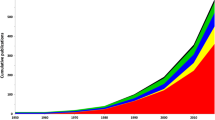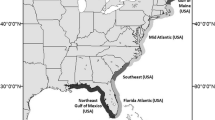Abstract
Pseudophoxinus a freshwater fish genus shows remarkable diversification with high number of endemic species in Anatolia. Most of the species of the genus are categorized as endangered for conservation in IUCN Red List due to water abstraction and habitat destruction. The aim of the study is to investigate genetic and morphological structure of Pseudophoxinus populations using allozyme, microsatellite markers and geometric morphometrics (eight landmarks). Sample collection was performed from eight localities for four different Pseudophoxinus species (P. Crassus, P. battalgili, P. egridiri, P. sp) in Anatolia in 2006. Genetic variation was assessed by using six microsatellite and ten allozyme loci. In total, 39 alleles for allozymes and 103 alleles for microsatellites were encountered in all populations. Mean observed heterozygosity was found in the range of 0.0143–0.0875 in allozymes and 0.146 to 0.463 in microsatellites. Significant morphological and genetic differentiation was measured among P. Crassus populations that may indicate to be considered different units in conservation action plans. There was no population differentiation detected by morphological and genetic measurements among P.battalgili populations. Bayesian individual assignment from Structure software revealed that P. battalgili populations are highly mixed in four sampling areas.





Similar content being viewed by others
References
Balik S (1995) Fresh-Water Fish in Anatolia, Turkey. Biological Conservation 72(2):213–223
Bogutskaya NG, Küçük F, Atalay A (2007) A description of three new species of the genus Pseudophoxinus from Turkey (Teleostei: Cyprinidae: Leuciscinae). Zoosystematica Rossica 15:335–341
Bookstein FL (1996) Biometrics, biomathematics and the morphometric synthesis. Bull Math Biol 58:313–365
Cardin S (2000) Advances in morphometric identification of fishery stocks. Rev Fish Biol Fish 10:91–112
Chapuis M, Estoup A (2007) Microsatellite null alleles and estimation of population differentiation. Mol Biol Evol 24:621–631
Crooijmans A, Vander J, Groene M, Groenen M (1997) Microsatellite markers in common carp (Cyprinus carpio L.). Anim Genet 28:129–134
Dakin EE, Avise JC (2004) Microsatellite null alleles in parentage analysis. Heredity 93:504–509
Dempster AP, Laird NM, Rubin DB (1977) Maximum likelihood from incomplete data via the EM algorithm. J R Stat Soc B 39:1–38
DeWoody JA, Avise JC (2000) Microsatellite variation in marine, freshwater and anadromous fishes compared with other animals. Journal of Fish Biology 56:461–473
Douglas ME, Douglas MR, Lynch JM, McElroy DM (2001) Use of Geometric Morphometrics to Differentiate Gila (Cyprinidae) within the Upper Colorado River Basin. Copeia 2:389–400
Evanno G, Regnaut S, Goudet J (2005) Detecting the number of clusters of individuals using the software STRUCTURE: a simulation study. Mol Ecol 14:2611–2620
Freyhof J, Özulug M (2010) Pseudophoxinus hittitorum, a new species of spring minnow from Central Anatolia (Teleostei: Cyprinidae). Ichthyol Explor Freshwaters 21(3):239–245
Geldiay R and Balık S (1988) Freshwater Fishes in Turkey, Ege University Faculty of Science Publication Series No: 97 Turkey
Goudet J (2001) FSTAT, a program to estimate and test gene diversities and fixation indices (version 2.9.3). http://www.unil.ch/izea/softwares/fstat.html
Hedenskog M, Petersson E, Järvi T (1997) Morphometric characters in wild produced Atlantic salmon (Salmo salar), brown trout (S. trutta), and their hybrids. Nordic Journal of Freshwater Research 73:35–43
Hrbek T, Stolting KN, Bardakci F, Küçük F, Rudolf H, Wildekamp RH, Meyera A (2004) Plate tectonics and biogeographical patterns of the Pseudophoxinus (Pisces: Cypriniformes) species complex of central Anatolia, Turkey. Molecular Phylogenetics and Evolution 32:297–308
Innal D (2013) Identifying growth parameters for two endemic species [Capoeta antalyensis (Battalgil, 1943) and Pseudophoxinus antalyae Bogutskaya, 1992] in Duden Creek, Antalya. Turkey J Appl Ichthyol. doi:10.1111/jai.12191
Klingenberg CP (2011) MorphoJ: an integrated software package for geometric morphometrics. Molecular Ecology Resources 11:353–357
Koca HU, Ölmez M (2013) Age, growth and mortality of Pseudophoxinus fahrettini Freyhof and Özuluğ, 2009 in Aksu stream - Köprüçay River (Isparta, Turkey). International Journal of Agricultural Policy and Research 1(4):124–130
Küçük F, İkiz R (2004) Antalya Körfezi’ne Dökülen Akarsuların Balık Faunası. E.U. Journal of Fisheries & Aquatic Sciences 21(3):287–294
Maltagliati F (1998) Allozyme differences between two endangered Mediterranean killifishes, Aphanius iberus and A. fasciatus (Teleostei: Cyprinodontidae). Ital. J. Zool 65:303–306
MCGuigan K, Franklin EC, Mortiz C, Blows MW (2003) Adaptation of Rainbow fish to lake and stream habitats. Evolution 57(1):104–118
Mesquita N, Cunha C, Hänfling B et al. (2003) Isolation and characterization of polymorphic microsatellite loci in the endangered Portuguese freshwater fish Squalius aradensis (Cyprinidae). Molecular Ecology Notes 3:572–574
Moritz C (1994) Defining “evolutionarily significant units” for conservation. Trends Ecol Evol 9:373–375
Nei M (1973) The theory and estimation of genetic distance. pp. 45–54. In: Genetic Structure of Populations. University Hawaii Press: Honolulu
O’Connell M, Dillon MC, Wright JM, Bentzen P, Merkouris S, Seeb J (1998) Genetic structuring among Alaskan Pacific herring populations identified using microsatellite variation. J Fish Biol 53:150–163
O’Reilly PT, Canino MF, Bailey KM, Bentzen P (2004) Inverse relationship between Fst and microsatellite polymorphism in the marine fish, walleye pollock (Theragra chalcogramma): implications for resolving weak population structure. Mol Ecol 13:1799–1814
Pasteur N, Pasteur G, Bonhomme F, Catalan J, Britton-Davidian J (1988) Practical Isozyme Genetics. Ellis Horwood, Chichester
Peakall R, Smouse PE (2006) GENALEX 6: genetic analysis in Excel. Population genetic software for teaching and research. Mol Ecol Notes 6:288–295
Perea S, Böhme M, Zupancic P, Freyhof J, Šanda R, ÖzulugM AA, Ignacio Doadrio I (2010) Phylogenetic relationships and biogeographical patterns in Circum-Mediterranean subfamily Leuciscinae (Teleostei, Cyprinidae) inferred from both mitochondrial and nuclear data. Evolutionary Biology 10:1–27
Pritchard JK, Stephens M, Donnelly P (2000) Inference of population structure using multilocus genotype data. Genetics 155:945–959
Raymond M, Rousset F (1995) GENEPOP (version 1.2): population genetics software for exact tests and ecumenicism. J. Heredity 86:248–249
Rice WR (1989) Analyzing table of statistical tests. Evolution 43:223–225
Rohlf FJ (2004) tpsDig, digitize landmarks and outlines, version 2.0. Department of Ecology and Evolution, State University of New York at Stony Brook
Rohlf FJ, Marcus LF (1993) A revolution in morphometrics. Trends Ecol Evol 8:129–132
Rohlf FJ, Slice DE (1990) Extensions of the Procrustes method for the optimal superimposition of landmarks. Syst Zool 39:40–59
Şengör AMC, Altiner D, Cin A, Ustaomer T, Hsü KJ (1988) Origin and assembly of the Tethyside orogenic collage at the expense of Gondwana Land. In: Audley-Charles, M.G., Hallam, A. (Eds.), Gondwana and the Tethys. Geological Society Special Publications No. 37. Geol. Soc. Special Pub. No. 37. Oxford University Press, New York, NY
Slice DE (1998) Morpheus et al.: software for morphometric research. Revision 01-30-98-Beta. Department of ecology and evolution, State University of New York, Stony Brook: New York.
Van Oosterhout C, Hutchinson WF, Willis DP, Shipley P (2004) Micro-checker: software for identifying and correcting genotyping errors in microsatellite data. Mol Ecol Notes 4:535–538
Ward RD, Woodwark M, Skinbinski DOF (1994) A comparison of genetic diversity levels in marine, freshwater and anadromous fishes. J Fish Biol 44:213–232
Acknowledgments
This study was supported by The Scientific & Technological Research Council of Turkey (TÜBİTAK) and Middle East Technical University (METU). We are grateful to James Rohlf, Dean Adams, and Murat Aytekin for their advice and helpful comments about geometric morphometrics measurements, Fahrettin Küçük and Güler Ekmekçi for their help during field trip, Ergi Deniz Özsoy and Murat Yıldırım for their help in allozyme analyses. Special thanks to Donna Gordon for her revision.
Author information
Authors and Affiliations
Corresponding author
Additional information
Equal contribution, Telli Murat and Kence Aykut
Rights and permissions
About this article
Cite this article
Murat, T., Aykut, K. Genetic and morphologic diversity of Pseudophoxinus (Cyprinidae): implication for conservation in Anatolia. Environ Biol Fish 98, 571–583 (2015). https://doi.org/10.1007/s10641-014-0291-2
Received:
Accepted:
Published:
Issue Date:
DOI: https://doi.org/10.1007/s10641-014-0291-2




